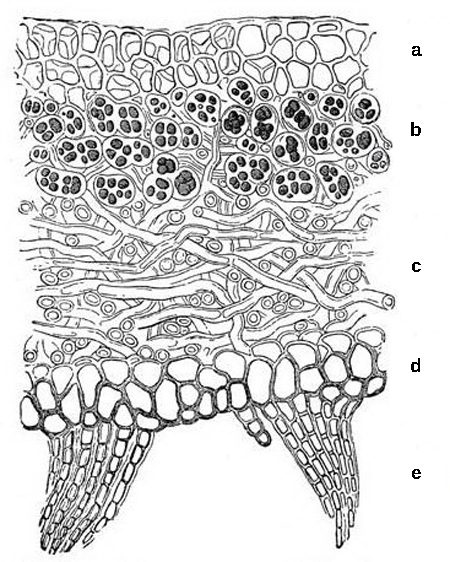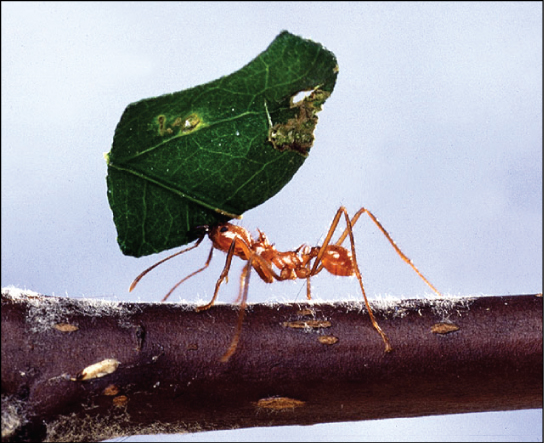| << Chapter < Page | Chapter >> Page > |
Explore the world of lichens using this site from Oregon State University.

Lichens are not a single organism, but rather an example of a mutualism, in which a fungus (usually a member of the Ascomycota or Basidiomycota phyla) lives in close contact with a photosynthetic organism (a eukaryotic alga or a prokaryotic cyanobacterium) ( [link] ). Generally, neither the fungus nor the photosynthetic organism can survive alone outside of the symbiotic relationship. The body of a lichen, referred to as a thallus, is formed of hyphae wrapped around the photosynthetic partner. The photosynthetic organism provides carbon and energy in the form of carbohydrates. Some cyanobacteria fix nitrogen from the atmosphere, contributing nitrogenous compounds to the association. In return, the fungus supplies minerals and protection from dryness and excessive light by encasing the algae in its mycelium. The fungus also attaches the symbiotic organism to the substrate.

The thallus of lichens grows very slowly, expanding its diameter a few millimeters per year. Both the fungus and the alga participate in the formation of dispersal units for reproduction. Lichens produce soredia , clusters of algal cells surrounded by mycelia. Soredia are dispersed by wind and water and form new lichens.
Lichens are extremely sensitive to air pollution, especially to abnormal levels of nitrogen and sulfur. The U.S. Forest Service and National Park Service can monitor air quality by measuring the relative abundance and health of the lichen population in an area. Lichens fulfill many ecological roles. Caribou and reindeer eat lichens, and they provide cover for small invertebrates that hide in the mycelium. In the production of textiles, weavers used lichens to dye wool for many centuries until the advent of synthetic dyes.
Lichens are used to monitor the quality of air. Read more on this site from the United States Forest Service.
Fungi have evolved mutualisms with numerous insects in Phylum Arthropoda: jointed, legged invertebrates. Arthropods depend on the fungus for protection from predators and pathogens, while the fungus obtains nutrients and a way to disseminate spores into new environments. The association between species of Basidiomycota and scale insects is one example. The fungal mycelium covers and protects the insect colonies. The scale insects foster a flow of nutrients from the parasitized plant to the fungus. In a second example, leaf-cutting ants of Central and South America literally farm fungi. They cut disks of leaves from plants and pile them up in gardens ( [link] ). Fungi are cultivated in these disk gardens, digesting the cellulose in the leaves that the ants cannot break down. Once smaller sugar molecules are produced and consumed by the fungi, the fungi in turn become a meal for the ants. The insects also patrol their garden, preying on competing fungi. Both ants and fungi benefit from the association. The fungus receives a steady supply of leaves and freedom from competition, while the ants feed on the fungi they cultivate.

Animal dispersal is important for some fungi because an animal may carry spores considerable distances from the source. Fungal spores are rarely completely degraded in the gastrointestinal tract of an animal, and many are able to germinate when they are passed in the feces. Some dung fungi actually require passage through the digestive system of herbivores to complete their lifecycle. The black truffle—a prized gourmet delicacy—is the fruiting body of an underground mushroom. Almost all truffles are ectomycorrhizal, and are usually found in close association with trees. Animals eat truffles and disperse the spores. In Italy and France, truffle hunters use female pigs to sniff out truffles. Female pigs are attracted to truffles because the fungus releases a volatile compound closely related to a pheromone produced by male pigs.
Fungi have colonized nearly all environments on Earth, but are frequently found in cool, dark, moist places with a supply of decaying material. Fungi are saprobes that decompose organic matter. Many successful mutualistic relationships involve a fungus and another organism. Many fungi establish complex mycorrhizal associations with the roots of plants. Some ants farm fungi as a supply of food. Lichens are a symbiotic relationship between a fungus and a photosynthetic organism, usually an alga or cyanobacterium. The photosynthetic organism provides energy derived from light and carbohydrates, while the fungus supplies minerals and protection. Some animals that consume fungi help disseminate spores over long distances.
[link] If symbiotic fungi are absent from the soil, what impact do you think this would have on plant growth?
[link] Without mycorrhiza, plants cannot absorb adequate nutrients, which stunts their growth. Addition of fungal spores to sterile soil can alleviate this problem.

Notification Switch
Would you like to follow the 'Biology' conversation and receive update notifications?